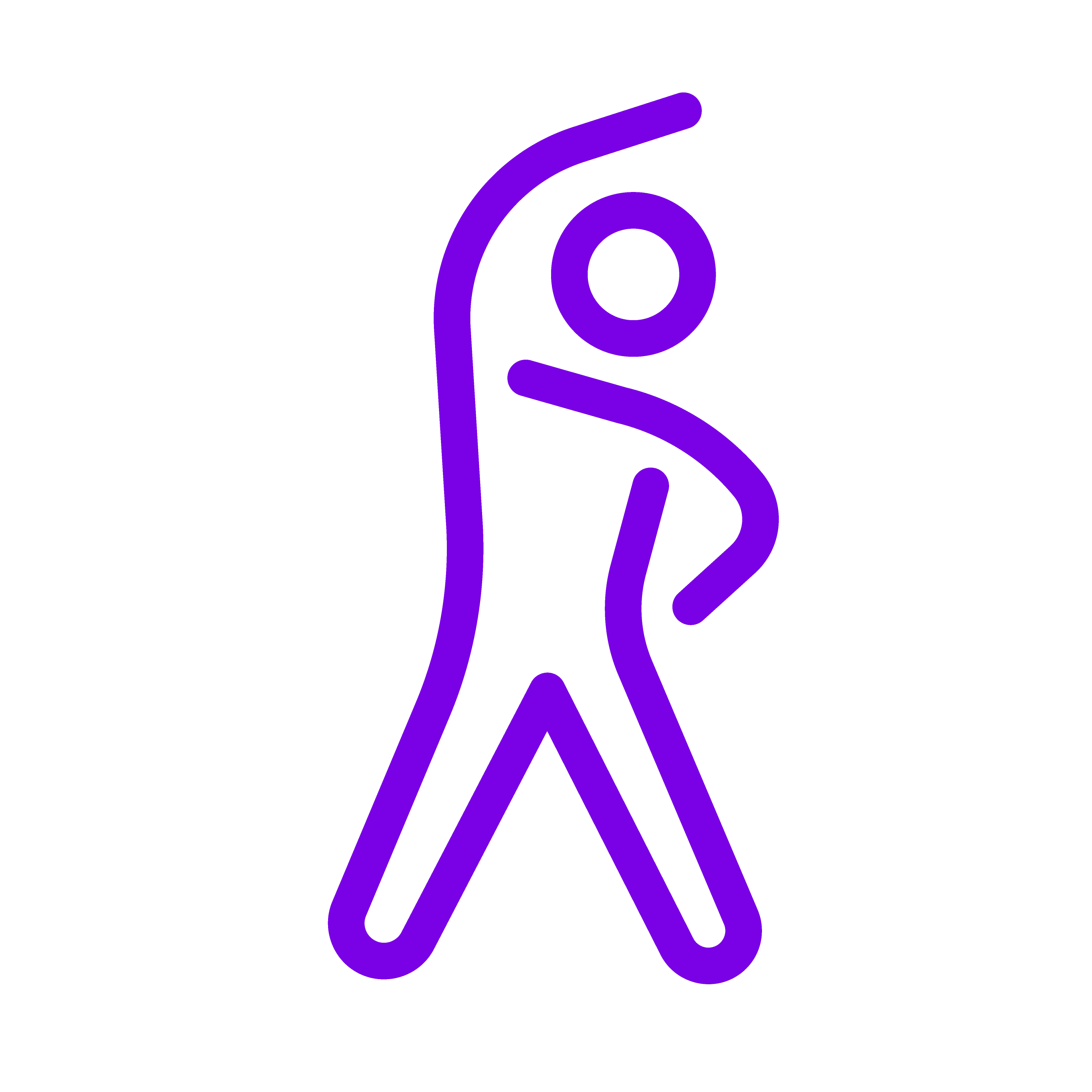Reading time: 5 min.
| Which factors can affect blood glucose?
Complexity of type 1-diabetes
Navigating the complexities of type 1-diabetes involves understanding how factors such as diet, exercise, sleep, medication, and even weather patterns can influence blood glucose. On this page, we unravel the intricate relationship between diet, physical activity, and blood glucose management for individuals with type 1-diabetes.
Food is composed of carbohydrates, fat, and proteins. Particularly, carbohydrates are significant when dealing with type 1 diabetes, as they have a significant impact on blood sugar.
To supply energy to the body's cells, it is necessary to eat food. The food we consume consists of varying amounts of carbohydrates, fat, proteins, and in some cases, alcohol. Additionally, food contains essential nutrients in the form of vitamins and minerals. Each component plays a role in the body:
• Carbohydrates contribute dietary fibers, whole grains, and energy to the brain and muscles.
• Proteins are the building blocks for muscles and tissues and play a crucial role in the body's immune defense.
• Fat provides essential fatty acids, ensures the absorption of fat-soluble vitamins, and benefits the heart.
• Vegetables and fruits contribute vitamins, minerals, antioxidants, and dietary fibers.
When you have diabetes, it is important to maintain as stable blood sugar as possible. It is also crucial to understand how your body and blood sugar react to the food you eat.
The effect of a meal on blood sugar peaks around 1.5 hours after consumption, but it depends on the composition of the meal. By measuring blood sugar both before and 1-2 hours after a meal, you can gain a better understanding of how different foods affect your blood sugar.
Carbohydrates are one of the body's primary sources of energy for the brain and muscles. At the same time, it is the component in food that primarily causes blood sugar to rise. It is important not to exclude carbohydrates from meals. Instead, consider the quality and quantity of the carbohydrates you consume.
Carbohydrates convert to sugar: Carbohydrates mainly convert to sugar (glucose) in the gastrointestinal tract. From there, they are transferred to the blood to be transported to all cells in the body. The effect on blood sugar typically peaks about one and a half hours after a meal.
Fast and slow carbohydrates: Some carbohydrates convert to sugar faster than others.
Carbohydrates are thus divided into two types:
Fast carbohydrates and slow carbohydrates: Both types cause blood sugar to rise. However, slow carbohydrates result in a slower increase in blood sugar and a more stable blood sugar level.
Body's need for carbohydrates: The body's need for calories and carbohydrates depends on age, gender, size, physical activity level, and the type of blood sugar-lowering medication taken.
Carbohydrate-rich food: Carbohydrates are found especially in bread, flour, grains, cereal, rice, pasta, bulgur, couscous, legumes, potatoes, milk, dairy products like yogurt, as well as in sugary products, chips, fast food, fruit, and to a lesser extent in vegetables.
Fat is important for various body functions, including the absorption of fat-soluble vitamins. Fat is divided into saturated fat, unsaturated fat, and polyunsaturated fat.
It is important to pay attention to the type of fat and the fat content when choosing food products. The majority of the fat you consume should be unsaturated. Unsaturated fat provides essential fatty acids and reduces the risk of cardiovascular diseases. Saturated fat increases the risk of cardiovascular diseases.
Fat and blood sugar: Fat does not directly affect blood sugar. However, very fatty food can delay the emptying of the stomach, thus reducing and delaying the increase in blood sugar.
Fat's impact on cholesterol levels and weight: Fat from food also affects blood lipids (cholesterol and triglycerides).Saturated fat negatively affects cholesterol levels by increasing total and LDL cholesterol (the so-called "bad cholesterol").
Unsaturated fat positively affects cholesterol levels by lowering total and LDL cholesterol. As fat contains many calories, it is a good idea to consume less of it if you want to lose weight.
Food rich in saturated fat: Saturated fat is found especially in animal products like fatty meat and cold cuts, sausages, fatty dairy products, cream, sour cream, butter, and ice cream. Additionally, there is often saturated fat in cakes, biscuits, and light chocolate.
Saturated fat should be replaced with unsaturated fat rather than increasing carbohydrate intake in the diet to achieve the heart-friendly effect.
Food rich in unsaturated fat: Unsaturated fat is found especially in vegetable oil (including rapeseed oil and olive oil), margarine, almonds, nuts, avocado, olives, and fish.
Proteins are used to build and maintain the body. Moreover, they play a crucial role in the body's immune defense.
Proteins and blood sugar: Proteins can affect blood sugar, but to a much lesser extent than carbohydrates. Especially if you limit the amount of carbohydrates in your food and increase the protein intake, it can play a role in blood sugar elevation.
Food rich in proteins: Proteins are found in meat, fish, cold cuts, dairy products, cheese, eggs, and dried legumes. Generally, it is not necessary to take protein supplements. If you have impaired kidney function, supplements or a high protein intake may be harmful.
When you are active, your muscles use more sugar than when you are sitting still. Initially, the body utilizes sugar (carbohydrates) as an energy source. Each time you eat and administer insulin, a portion of the carbohydrates is stored, primarily in the liver but also in muscle and fat cells.
When you are active, your body will deplete these sugar stores. Once these stores are used up, your blood sugar will decrease.
Different types of exercies impact blood sugar in different ways:
High-intensity activity (anaerobic activity): Just a few seconds of such activity can cause your blood sugar to rise. The reason is that the body releases the hormones adrenaline and glucagon.
The increase in blood sugar is temporary and typically lasts for 30-60 minutes. After the activity, blood sugar may then decrease in the hours that follow. Examples of such activity include strength/weightlifting, interval training with very high intensity, and sprinting.
Endurance training (aerobic activity): This type of activity often leads to a decrease in blood sugar, both during and after the activity. Examples of such activity include walking, swimming, cycling, running, or other endurance sports.
Combination of high intensity and endurance: Some activities involve both anaerobic and aerobic intensity, such as football. In such cases, blood sugar will be influenced by both anaerobic and aerobic training.
The extent to which and how exercise affects blood sugar can also be individual. It may be wise for you to measure and monitor your blood sugar to understand how you respond to different forms of activity.
Exercise is a key pillar of metabolic health in people with diabetes, and benefits of working out with type 1 diabetes include:
 Improved Physical Fitness and Strength: Engaging in regular physical exercise can lead to significant improvements in physical fitness and strength for patients with Type 1 Diabetes. Studies, such as Chimen et al. (2012), have shown that exercise can enhance cardiovascular endurance, muscular strength, and overall physical performance, contributing to better functional capacity and quality of life.
Improved Physical Fitness and Strength: Engaging in regular physical exercise can lead to significant improvements in physical fitness and strength for patients with Type 1 Diabetes. Studies, such as Chimen et al. (2012), have shown that exercise can enhance cardiovascular endurance, muscular strength, and overall physical performance, contributing to better functional capacity and quality of life.
 Reduced Insulin Requirements: Physical exercise has the remarkable ability to increase insulin sensitivity in individuals with Type 1 Diabetes, leading to reduced insulin requirements. As highlighted in the study by Bai et al. (2021), regular exercise can help patients achieve better glycemic control, potentially lowering the reliance on exogenous insulin and improving diabetes management.
Reduced Insulin Requirements: Physical exercise has the remarkable ability to increase insulin sensitivity in individuals with Type 1 Diabetes, leading to reduced insulin requirements. As highlighted in the study by Bai et al. (2021), regular exercise can help patients achieve better glycemic control, potentially lowering the reliance on exogenous insulin and improving diabetes management.
 Reduced Cardiovascular Risk Factors: Incorporating exercise into the daily routine of Type 1 Diabetes patients can positively impact cardiovascular risk factors. Research suggests that exercise can lower blood pressure, improve lipid profiles, and reduce the risk of obesity, all of which contribute to a healthier cardiovascular profile and a reduced risk of heart-related complications.
Reduced Cardiovascular Risk Factors: Incorporating exercise into the daily routine of Type 1 Diabetes patients can positively impact cardiovascular risk factors. Research suggests that exercise can lower blood pressure, improve lipid profiles, and reduce the risk of obesity, all of which contribute to a healthier cardiovascular profile and a reduced risk of heart-related complications.
 Associated with Reduced Risk of Microvascular Complications: Evidence from Chimen et al. (2012) and other studies indicates that engaging in regular physical exercise is associated with a decreased risk of microvascular complications in Type 1 Diabetes patients. These complications, such as retinopathy, neuropathy, and nephropathy, can be mitigated by the positive effects of exercise on glycemic control and overall vascular health.
Associated with Reduced Risk of Microvascular Complications: Evidence from Chimen et al. (2012) and other studies indicates that engaging in regular physical exercise is associated with a decreased risk of microvascular complications in Type 1 Diabetes patients. These complications, such as retinopathy, neuropathy, and nephropathy, can be mitigated by the positive effects of exercise on glycemic control and overall vascular health.
 Reduced Cardiovascular Disease and Mortality: Exercise has been shown to have a protective effect against cardiovascular disease and mortality in individuals with Type 1 Diabetes. By improving cardiovascular health, exercise can reduce the risk of heart attacks, strokes, and other cardiovascular events, ultimately leading to improved longevity and well-being.
Reduced Cardiovascular Disease and Mortality: Exercise has been shown to have a protective effect against cardiovascular disease and mortality in individuals with Type 1 Diabetes. By improving cardiovascular health, exercise can reduce the risk of heart attacks, strokes, and other cardiovascular events, ultimately leading to improved longevity and well-being.
 Improved Cognitive Function: Research indicates that exercise may positively influence cognitive function in individuals with Type 1 Diabetes. Regular physical activity has been associated with enhanced memory, attention, and overall cognitive performance, providing additional benefits beyond glycemic control and cardiovascular health.
Improved Cognitive Function: Research indicates that exercise may positively influence cognitive function in individuals with Type 1 Diabetes. Regular physical activity has been associated with enhanced memory, attention, and overall cognitive performance, providing additional benefits beyond glycemic control and cardiovascular health.
 Greater Satisfaction with Life and Well-being: Physical exercise is not only beneficial for physical health but also for mental and emotional well-being. Studies have demonstrated that regular exercise is associated with increased satisfaction with life and overall well-being in Type 1 Diabetes patients. Engaging in enjoyable physical activities can boost mood, reduce stress, and improve mental health.
Greater Satisfaction with Life and Well-being: Physical exercise is not only beneficial for physical health but also for mental and emotional well-being. Studies have demonstrated that regular exercise is associated with increased satisfaction with life and overall well-being in Type 1 Diabetes patients. Engaging in enjoyable physical activities can boost mood, reduce stress, and improve mental health.
In conclusion, physical exercise offers a myriad of benefits for patients with Type 1 Diabetes, ranging from improved physical fitness and reduced insulin requirements to enhanced cardiovascular health and greater well-being. Emphasizing the importance of regular exercise in diabetes management can significantly improve patients' overall health and quality of life.
1. Riddell MC, Turner LV, and Patton SR. Is there an optimal time of day for exercise? A commentary on when to exercise for people living with type 1 or type 2 diabetes. Diabetes Spectr. 2023;36(2):146–50. doi: 10.2337/dsi22-0017. PMID: 37193212.
MAT-DK-2400107
